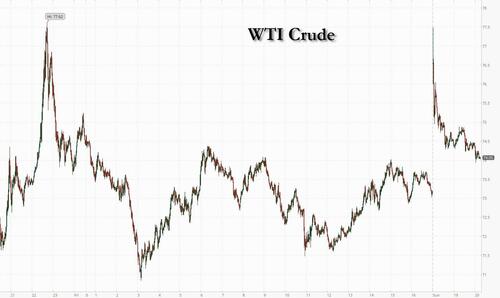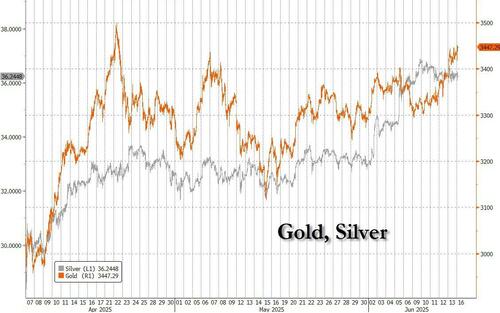Oil jumped in late Sunday trading with investors focused on escalating geopolitical tensions as Israel and Iran continue to bombard each other with no sign of a pause, amid some speculation the worst-case scenario – a blockade of the straits of Hormuz which could send oil as high as $130 – is increasingly likely (odds rising to 17% according to JPM).
Brent crude rose as much as 5.5% to $77.50 – its Thursday night high – in early Asian trading after Israel and Iran continued attacks on one another’s territories over the weekend. The price then promptly ease back as shorts who stand to suffer massive losses in case of a squeeze, doubled down by shorting even more in hopes the crises somehow de-escalates.
That’s a problem because unlike late last week, over the weekend Israel started attacking Iran’s energy infrastructure, and on Saturday launched an attack on the giant South Pars gas field in the Persian Gulf, forcing the shut down of a production platform, after air strikes on Iran’s nuclear sites and military leadership last week.
Asian equity-index futures pointed to declines in Hong Kong and Sydney, while contracts for US equities initially edged lower before stubborn retail dip buyers promptly emerged again. The dollar saw modest gains against major peers in early trading, while gold rose toward a record on Monday as the conflict drove investors toward haven assets.
Last week’s biggest market reaction to the conflict was oil, with crude prices surging more than 13% on Friday before paring some of those gains. The biggest concern for the market centers on the Strait of Hormuz and prices could soar further if Iran attempts to block the route. On Saturday, JPMorgan raised its odds of a Hormuz closure to 17%.
“Markets should be prepared for a prolonged period of uncertainty,” said Wolf von Rotberg, an equity strategist at Bank J. Safra Sarasin, quoted by Bloomberg. “Hedging against potential oil supply-chain disruptions via exposure to the energy market and adding to gold, which may see an acceleration of its structural uptrend, are the best ways to protect a portfolio against a further escalation in the Middle East.”
Some investors ended last week choosing to wait to gauge how long the tensions would last, mindful of similar standoffs between the two nations that eventually de-escalated. Still, the extension of the conflict and intensity of the current hostilities is likely to cast a shadow over risk assets on Monday. Already, the MSCI World Index of developed-market equities fell the most since April on Friday following Israel’s initial air strikes on Iran.
“This is a significant escalation, to the point where these nations are at war,” said Michael O’Rourke, chief market strategist at JonesTrading. “The ramifications will be larger and last longer,” with weakness in equity markets likely, especially after recent gains, he said.
While the drop in US stock futures was modest, most Middle East stock indexes suffered bigger losses on Sunday. Egypt’s main gauge was the worst performer, seeing the biggest losses in more than a year on concern that a halt in Israeli gas production will cause fuel shortages. In Saudi Arabia, the Tadawul gauge’s declines were limited by Aramco, which gained on higher oil prices. Israel’s benchmark ended higher as military supplier Elbit Systems Ltd. rallied.
Still, judging by the recent dip-buying euphoria, one can see why some are confident that this too will blow over quickly.
“Unless oil stays elevated and drives inflation higher, this is more likely a pause than a panic as other narratives are driving the market,” said Dave Mazza, chief executive officer, Roundhill Investments. “It may present a buying opportunity, but with markets having rallied sharply off recent lows, gains from here will be harder to come by.”
Traders are weighing the fresh geopolitical risks at a time when they are also grappling with destabilized global trade relationships, the prospect of new tariffs from Donald Trump, economic cross-currents, the ongoing conflict between Russia and Ukraine and rising political tensions in the US amid protests.
Loading…



















